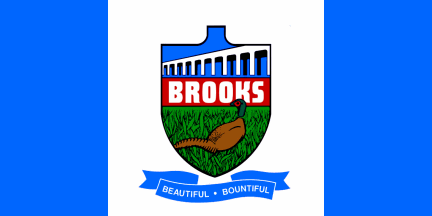 image by Eugene Ipavec, 9 October 2010
image by Eugene Ipavec, 9 October 2010
Last modified: 2012-08-09 by rob raeside
Keywords: alberta | brooks | brooks acquaduct | pheasant |
Links: FOTW homepage |
search |
disclaimer and copyright |
write us |
mirrors
 image by Eugene Ipavec, 9 October 2010
image by Eugene Ipavec, 9 October 2010
See also:
External Links:
The flag of the City of Brooks, Alberta, consists of three vertical stripes blue-white-blue, where the white stripe is wider, and the city crest in the middle of the white stripe. The city crest was designed by Lois Valli, a local artist, and is representative of our irrigation system, agriculture, and pheasants, and is described as follows:
The outer edge of the crest is the shape of a spade and is symbolic of the 270.000 acres of irrigated land supported by the Eastern Irrigation District which benefits both agriculture and more than 250 species of birds; The Brooks Aqueduct, represented by the white pillars behind "BROOKS", is a national/provincial historic site that was constructed more than 80 years ago. The site is an engineering marvel that is suspended 20 metres above the surface and was used to transfer water to newly settled farmers and ranchers; The Pheasant is a treasured species and annually thousands are released for hunting. Brooks is well known for Pheasant hunting all across Canada and United States; Grasses represent the numerous fields of flowing grasses surrounding the Brook District; The Banner - "Beautiful and Bountiful" was chosen by the artist as an expression of the vast open expanses of sky and prairie in the Brooks District.
Information courtesy of Amanda Peterson, City Clerk.
Valentin Poposki, 16 February 2010
About the city:
Originally, the area of Brooks was used as a buffalo hunting ground for the Blackfoot and Crow natives. After Treaty 7 was signed in 1887, homesteaders moved into the area to begin dry land farming. The arrival of the Canadian Pacific Railroad saw more settlers move to the area of Brooks. By 1904, Canada Post was interested in putting a post office in the settlement, however the area was still unnamed. By a Canada Post sponsored contest, the new area was named after Noel Edgell Brooks, a Canadian Pacific Railway Divisional Engineer from Calgary.
On July 14th, 1910, the Village of Brooks was formally established and became a Town a year later.
To encourage immigration and growth into the region in the early part of the century, the Canadian Pacific Railway began the construction of major irrigation works. These works included the two mile long Brooks Aqueduct, constructed over 2½ years and completed in 1915. In 1935, the C.P.R. transferred control of these works to local farmers and the Eastern Irrigation District was formed. Irrigation has allowed Brooks to become a service centre for highly effective livestock, grain and vegetable producing industries.
In more recent years Brooks has experienced growth due to the oil and gas industry. The late 70's and early 1980's saw Brooks' population grow from 5,000 to around 8,000. The oil and gas industry, and those activities that provide services to oil and gas exploration are still a large driving force in the continued growth of Brooks. The Town's population in 1996 for the first time exceeded 10,000, due in large part to expansion at Lakeside IBP meat packing plant, making Brooks the largest Town in Alberta.
On September 1, 2005, with an estimated population of 13,000, Brooks officially became the City of Brooks "Alberta's Centennial City". The trademark was established at this time to commemorate the event and to celebrate Alberta's Centennial year.
Valentin Poposki, 16 February 2010